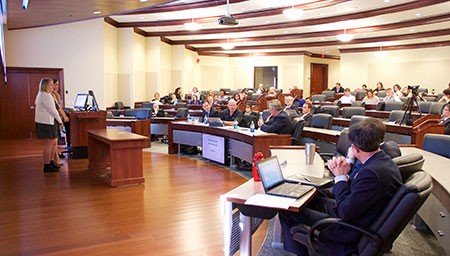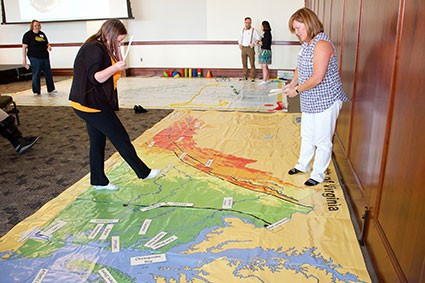Educators share their world at global education conference

As an assistant principal at Auburn Elementary School, Kim Rygas ’07, ’08 M.S., ’16 M.S., is compelled to help students and teachers at her school prepare for an ever-changing world.
It’s what brought Rygas back to her alma mater, Radford University, on Aug. 19 for the second annual RU World Ready? Global Education Conference, a day-long event that featured presenters who are successfully integrating global studies into their classroom curriculums.
“We all need to learn different things about different people, how to be empathetic and how to work with people around the world because the world is changing rapidly,” said Rygas, who also served as a co-presenter at the conference with a group of RU students who traveled to Malawi over the summer as part of a teaching and service initiative.
Radford University’s School of Teacher Education and Leadership (STEL) faculty members Glenna Gustafson, Terry Smith and Patti Talbot organized this year’s conference to serve the needs of pre-service and practicing teachers who are working to develop global competencies for themselves and their students, who soon will “enter a rapidly changing and ever more interconnected world.” Smith said.
Almost 200 current and future educators attended the conference, which featured experienced global educators from around the United States, as well as organizations such as National Geographic, Virginia Geographic Alliance and UNC WorldView.
Andrew J. Morikawa, a senior fellow at the Virginia Tech Institute for Policy and Governance, served as the conference’s keynote speaker. He spoke about the refugee crisis around the world, refugee children in the United States, and addressed “relationships of trust and safety” and “public school classrooms as places of refuge and resolve for the American future.”
Morikawa told the gathering that success depends on “you, as educators, that the American public school classroom is, and can be, a refuge of safe harbor for our children, where they can learn how to be and work together, fully expressing what it means to be American, free with liberty and justice for all.”
Before Morikawa spoke, Kenna Colley, dean of the College of Education and Human Development, talked about the importance of the event.
“This conference will allow us to see possibility, it will allow us to provide greater access to the world we live in through our own teaching and for our students. It will really help us to improve educational opportunities for all and light the pathway for future generations.”
Dylan Johnson teaches world history at Bassett High School. He attended the conference to learn more about improving those teaching opportunities and to explore new ways to introduce global studies into his curriculum.
“It’s important because many of our students don’t have a realization of what is truly out there,” he said after attending a morning session. “I think this conference will give us ideas to help them open their minds and eyes to the world and the possibilities they have once they graduate high school.”

Many conference attendees were Radford University students who are well on their way to becoming teachers, Smith said. One of those was Miranda Dalton, a Radford University graduate student who is preparing for a career as a middle school math and science educator because “that’s my calling,” she said.
A few hours into the conference, Dalton talked about the importance of attending the event, not only for her professional development, but for the development of her future students.
“I want to learn to better educate students on a global scale, and I feel middle school is a great time to plant that seed,” Dalton explained. “You have to help people understand that on an individual level before we can have it on a global level.”
At the event’s conclusion, Smith delighted in the success of the conference.
“We exposed the attendees to practical ideas about teaching lessons dealing with significant issues in the world,” Smith said.
Those, Smith said, included “the movement of refugees, cultural understanding and empathy, sharing educational approaches across cultures, using technology and social media to connect around the world, creating global projects, joining with international groups such as National Geographic, and taking advantage of resources in our own state with the Virginia Geographic Alliance.”
The third annual Global Education Conference will be held on the Radford University campus in 2018, Smith said.